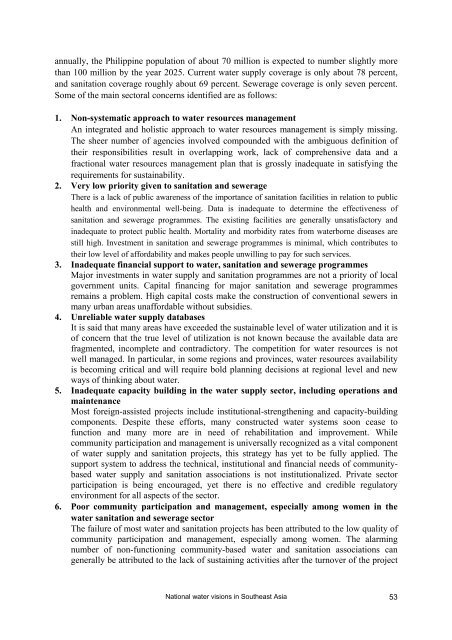The FAO-ESCAP pilot project on national water visions. From vision ...
The FAO-ESCAP pilot project on national water visions. From vision ...
The FAO-ESCAP pilot project on national water visions. From vision ...
You also want an ePaper? Increase the reach of your titles
YUMPU automatically turns print PDFs into web optimized ePapers that Google loves.
annually, the Philippine populati<strong>on</strong> of about 70 milli<strong>on</strong> is expected to number slightly more<br />
than 100 milli<strong>on</strong> by the year 2025. Current <strong>water</strong> supply coverage is <strong>on</strong>ly about 78 percent,<br />
and sanitati<strong>on</strong> coverage roughly about 69 percent. Sewerage coverage is <strong>on</strong>ly seven percent.<br />
Some of the main sectoral c<strong>on</strong>cerns identified are as follows:<br />
1. N<strong>on</strong>-systematic approach to <strong>water</strong> resources management<br />
An integrated and holistic approach to <strong>water</strong> resources management is simply missing.<br />
<str<strong>on</strong>g>The</str<strong>on</strong>g> sheer number of agencies involved compounded with the ambiguous definiti<strong>on</strong> of<br />
their resp<strong>on</strong>sibilities result in overlapping work, lack of comprehensive data and a<br />
fracti<strong>on</strong>al <strong>water</strong> resources management plan that is grossly inadequate in satisfying the<br />
requirements for sustainability.<br />
2. Very low priority given to sanitati<strong>on</strong> and sewerage<br />
<str<strong>on</strong>g>The</str<strong>on</strong>g>re is a lack of public awareness of the importance of sanitati<strong>on</strong> facilities in relati<strong>on</strong> to public<br />
health and envir<strong>on</strong>mental well-being. Data is inadequate to determine the effectiveness of<br />
sanitati<strong>on</strong> and sewerage programmes. <str<strong>on</strong>g>The</str<strong>on</strong>g> existing facilities are generally unsatisfactory and<br />
inadequate to protect public health. Mortality and morbidity rates from <strong>water</strong>borne diseases are<br />
still high. Investment in sanitati<strong>on</strong> and sewerage programmes is minimal, which c<strong>on</strong>tributes to<br />
their low level of affordability and makes people unwilling to pay for such services.<br />
3. Inadequate financial support to <strong>water</strong>, sanitati<strong>on</strong> and sewerage programmes<br />
Major investments in <strong>water</strong> supply and sanitati<strong>on</strong> programmes are not a priority of local<br />
government units. Capital financing for major sanitati<strong>on</strong> and sewerage programmes<br />
remains a problem. High capital costs make the c<strong>on</strong>structi<strong>on</strong> of c<strong>on</strong>venti<strong>on</strong>al sewers in<br />
many urban areas unaffordable without subsidies.<br />
4. Unreliable <strong>water</strong> supply databases<br />
It is said that many areas have exceeded the sustainable level of <strong>water</strong> utilizati<strong>on</strong> and it is<br />
of c<strong>on</strong>cern that the true level of utilizati<strong>on</strong> is not known because the available data are<br />
fragmented, incomplete and c<strong>on</strong>tradictory. <str<strong>on</strong>g>The</str<strong>on</strong>g> competiti<strong>on</strong> for <strong>water</strong> resources is not<br />
well managed. In particular, in some regi<strong>on</strong>s and provinces, <strong>water</strong> resources availability<br />
is becoming critical and will require bold planning decisi<strong>on</strong>s at regi<strong>on</strong>al level and new<br />
ways of thinking about <strong>water</strong>.<br />
5. Inadequate capacity building in the <strong>water</strong> supply sector, including operati<strong>on</strong>s and<br />
maintenance<br />
Most foreign-assisted <str<strong>on</strong>g>project</str<strong>on</strong>g>s include instituti<strong>on</strong>al-strengthening and capacity-building<br />
comp<strong>on</strong>ents. Despite these efforts, many c<strong>on</strong>structed <strong>water</strong> systems so<strong>on</strong> cease to<br />
functi<strong>on</strong> and many more are in need of rehabilitati<strong>on</strong> and improvement. While<br />
community participati<strong>on</strong> and management is universally recognized as a vital comp<strong>on</strong>ent<br />
of <strong>water</strong> supply and sanitati<strong>on</strong> <str<strong>on</strong>g>project</str<strong>on</strong>g>s, this strategy has yet to be fully applied. <str<strong>on</strong>g>The</str<strong>on</strong>g><br />
support system to address the technical, instituti<strong>on</strong>al and financial needs of communitybased<br />
<strong>water</strong> supply and sanitati<strong>on</strong> associati<strong>on</strong>s is not instituti<strong>on</strong>alized. Private sector<br />
participati<strong>on</strong> is being encouraged, yet there is no effective and credible regulatory<br />
envir<strong>on</strong>ment for all aspects of the sector.<br />
6. Poor community participati<strong>on</strong> and management, especially am<strong>on</strong>g women in the<br />
<strong>water</strong> sanitati<strong>on</strong> and sewerage sector<br />
<str<strong>on</strong>g>The</str<strong>on</strong>g> failure of most <strong>water</strong> and sanitati<strong>on</strong> <str<strong>on</strong>g>project</str<strong>on</strong>g>s has been attributed to the low quality of<br />
community participati<strong>on</strong> and management, especially am<strong>on</strong>g women. <str<strong>on</strong>g>The</str<strong>on</strong>g> alarming<br />
number of n<strong>on</strong>-functi<strong>on</strong>ing community-based <strong>water</strong> and sanitati<strong>on</strong> associati<strong>on</strong>s can<br />
generally be attributed to the lack of sustaining activities after the turnover of the <str<strong>on</strong>g>project</str<strong>on</strong>g><br />
Nati<strong>on</strong>al <strong>water</strong> visi<strong>on</strong>s in Southeast Asia 53
















